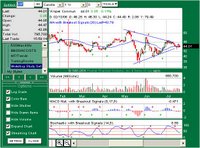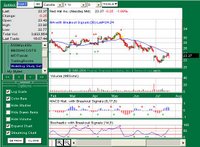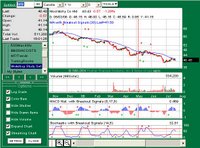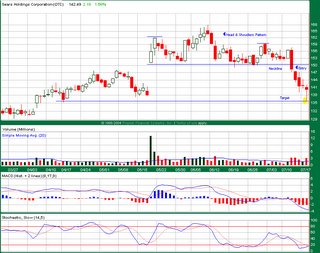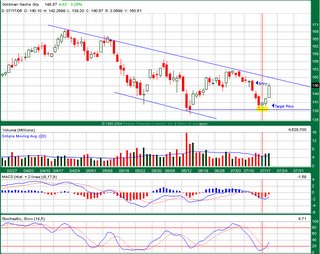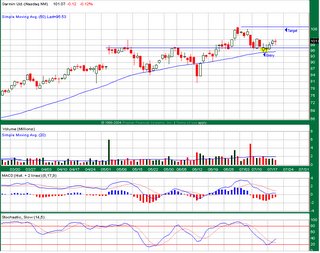This is an article I posted on the INVESTools site last week. It helps an entry level trader know what to take into consideration when deciding on what your "rules" or "apporach" will be. Take a look!
Creating a Trading System & Trading Rules
By Jeff Kohler
PHD Coach / Master Talk & Trading Rooms Instructor
In this weeks article I want to tackle the topic of developing trading systems and trading rules. Before we start this journey, I want to remind everyone that if you have not had success trading the initial system you purchased from INVESTools, you might want to review all of its rules and signals to make sure there were no misunderstandings along the way, and keep practicing with it until you get positive results. If you were not able to follow a system successfully, should you be trying to create one? Many of you have benefited from the INVESTools method, and based on your experiences, you have ideas of how to optimize its performance and produce better results. This is where the process of building a system and personalizing trading rules begins. You must arrive at an idea or a concept to get started. Through this article, I want to use a few examples and create a set of “mock rules” to give you an idea of how the process works.
General Principles
When coming up with a system or trading rules some of the elements you need to consider are…
A simple yet robust system- Come up with something easy to follow that generates good results.
Risk- understanding how risk plays a role in this, and determining how much you will risk per trade.
Longevity- Find something that will work no matter what the market encounters over the years.
Stock Selection/Diversification- Create a system that can apply to any stock, or only the specific stocks you trade.
Entry & Exit Signals- Create specifics to enter & exit. Test these methods to ensure their results.
Stop placement- Have exits planned for any scenario.
Record Keeping- Keep records of what you trade and why. This will also help create new rules and modify existing rules when needed.
Depending on how far you want to take this, you can add on as many topics to the list above that you wish. The more thorough your list is, the more systematic your trading becomes, and the more reliable your results can be.
What do you want to risk?
Most traders will confess that this concept is more important than the system itself. You need to develop an easy to use method for managing your risk in your trading. If you are not applying risk management now in your trading, do not delay this any further. Let me give you an example you might have read in your materials.
We teach our students to use a fixed percent of risk when they trade. Most will agree that 1-2% is an acceptable range to use. Let’s assume we have a $100,000 account value to trade with. Using a fixed percentage of risk would mean putting 1% ($1000) at risk per trade. This means that even if the trade goes completely against me, I would only lose $1000 per loss. (This does not mean I spend only $1000, this can mean I spend $5000, but set my stop so that I only lose $1000.) If you keep your losses small, you will give your winners a chance to outpace those losing trades.
Let’s translate this into a trading rule! Determine your risk management plan and follow it. Here are some examples. These might not apply to you, so when creating your own, make sure your rules follow your personal risk management plan.
Only put 1% of my account value at risk in an entire trade.
Only use 10% of my account to trade riskier investments such as options.
What types of stocks do you want to trade?
To some this is a very vague question, however a very important one. You need to establish guidelines of the quality of stocks you will select to hopefully lower your risk in a trade. This encompasses the fundamental quality of the stock, the industry group quality, the trend, etc. Some of the categories may or may not be important in your eyes, but focus on the ones that are. Here is a sample of items you might want to consider when answering this question.
Fundamental quality- Does the fundamental quality of the company matter to me? How do the scores look, do they meet my minimum criteria? (Ex. MG-Zacks of 3.25 or higher)
Technical quality- Is this stock in the right trend? Where does the price fall in relation to support & resistance?
Industry group quality- How does the stock measure to the industry? How does the industry measure against the market?
News & upcoming events- Are there any upcoming earnings announcements or news events that might affect the trade?
Diversification- How do I diversify myself? Do I trade similar stocks? Should I have trades in multiple groups? Should I consider ETF’s? Can I be both bullish & bearish in my account at the same time?
Let’s translate these criteria into rules! Here are a few examples.
Look for a Phase 1 score of 5 or better, and an MG-Zacks score of 3.25 or higher.
Stock must be in an established uptrend for the last two months, and have at least two touches each on a rising support and resistance line.
I must inspect the trend on a 5-year chart, then on a 1-year chart to see the bigger picture.
The stocks industry group must be in an uptrend.
I must inspect news and check when upcoming earnings announcements are scheduled.
Do not trade stocks that are too highly correlated. Consider ETF’s as an alternative to trading many stocks in a group generating the same trading signal.
Remember, these are only examples. When creating your rules they can be more specific, or less specific. They can be more restrictive, or less restrictive. Consider that the more restrictive you are, the less trades you will find. The more specific you are, the more systematic you will become.
Entry & Exit Signals
This can be a daunting task. There are many combinations you can use, various indicators to utilize, etc. Keep in mind the objective in this task. You are trying to find an entry point in the stocks you are watching, and you are trying to determine where you will get out of the trade. Before you start on the specifics, you need to come to terms with the type of trader you want to be. Are you going to trade the trend of a stock, and stay with that trend until the trend fails, or are you the short term trader who wants to trade short term movements in the overall trend? Once answered, this will be one of the more important questions you will answer about your trading approach. As we determine our rules, consider the following:
Anticipate or confirm? - Am I anticipating a movement from the stock, or do I wait until the move happens, and is confirmed by my indicators? Do remember that waiting for confirmation from your signals is conservative, has a higher probability of success, yet lower reward potential. Anticipating movements is more aggressive, has a lower probability of success, yet a higher reward potential.
Establishing a trend? - Does the trend matter in this trade? If so, should this trend be established over a minimum period of time?
Support & Resistance- Do I get in as the stock bounces off support, or breaks above resistance?
Indicators- What indicators should I use to generate buy & sell signals? Should I use the indicators conservatively (confirmation) or aggressively (anticipate)?
Let’s create some sample rules based on the topic above! Here are a few examples:
Make sure I am trading with the direction of the trend. The trend must consist of at least two higher highs, and two higher lows.
Wait for the stock to bounce off a recent support level. Determine the distance between support & resistance and make sure the distance is enough to justify the trade.
Using a MACD and Stochastic, wait for both indicators to be low and turning upward. As they change direction and the stock confirms support, take a position with the prevailing trend.
Aim for upper resistance as my target price. Plan for an exit at my target price, however if the MACD and Stochastic start to head down before reaching my target take profits at this time.
Upon entry, if the stock breaks support at any time, exit the trade.
Where should I set my stops?
Bruce Kovner, a very successful trader who was interviewed in the book “Market Wizards” says, “Place your stops at a point that, if reached, will reasonably indicate that the trade is wrong, not at a point determined primarily by the maximum dollar amount you are willing to lose.” Some traders use support and resistance lines to know where to extent stop orders, some use technical indicators such as an ATR or a parabolic SAR, some use fixed percentages based on the price of the stock or option. There are many ways to do this, so pick one! Here is an example of a trading rule for setting stops.
1. Identify support, and set a stop order 3% below (to allow for intra-day fluctuations.)
2. Set an initial trailing stop order to follow the trade by 10%. For example, if my option premium increases $1.00, my stop order tightens by 10% locking in a portion of the gain.
Final Thoughts
This is a crucial step in your trading. The 15 rules we created here today are basic ideas you might consider as you formulate your own rules. Like I mentioned earlier, these rules can be more specific, or less specific. They can be more restrictive, or less restrictive. Consider that the more restrictive you are, the less trades you will find. The more specific you are, the more systematic you will become. Try to cover most of the elements you will encounter in a trade. I also want you to keep in mind that in order to make sure your system/rules work; they will likely require some backtesting. This means you should take a few stocks going back a few years, and test your rules. For instance if your signal to buy was three green arrows, and your signal to sell was three red arrows, go back on these stocks and see if your approach would have been profitable or not. Your rules may need some adjustments along the way, but these rules are not to be broken. Make sure you know the difference.













